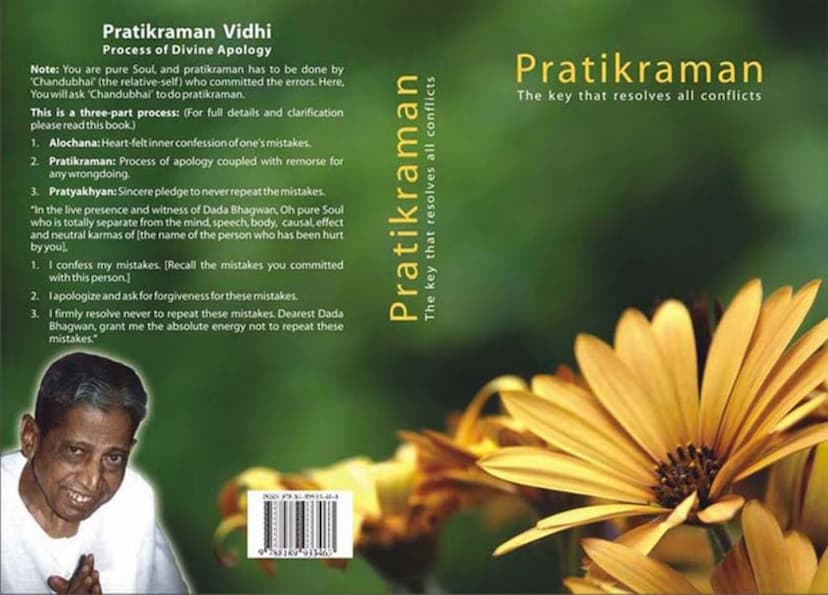Pratikramana Full Version
Added to library: September 2, 2025

Summary
This comprehensive summary is based on the provided text of "Pratikraman Full Version" by Dada Bhagwan, published by Mahavideh Foundation. The book expounds on the Jain concept of Pratikraman, presented as a key to resolving conflicts, and its scientific application in achieving Self-realization and liberation.
Core Concept of Pratikraman:
Pratikraman is presented as a three-part process designed to purify oneself from mistakes and negative tendencies, ultimately leading to spiritual progress and liberation. The three parts are:
- Alochana: A heartfelt inner confession of one's mistakes.
- Pratikraman: The process of apology coupled with remorse for any wrongdoing. This is emphasized as the crucial step for cleansing.
- Pratyakhyan: A sincere pledge to never repeat the mistakes.
The text stresses that pratikraman is not a mere ritual but a scientific process that, when done with genuine remorse and a firm resolve, can effectively neutralize karma and resolve conflicts. It is also presented as a method to prevent the binding of new karma.
The Teaching of Dada Bhagwan (Akram Vignan):
The book is based on the teachings of Param Pujya Dadashri "Dada Bhagwan" (Ambalal M. Patel), a Gnani Purush (an enlightened being) who attained spontaneous Self-Realization in 1958. Dada Bhagwan revealed the Akram Vignan path, a direct, step-less path to Self-realization, which can be attained in just two hours through a scientific experiment called the Gnan Vidhi. The core of His teaching is the understanding of the pure Soul (Shuddhatma) as being separate from the ego and the body-mind-speech complex (Chandubhai, the relative self).
Key Principles and Practices:
- Awareness of the Self: The ultimate goal is to remain constantly aware of the pure Soul, separate from the non-Self complex.
- Pratikraman for Atikraman: Atikraman (mistakes or aggression through thoughts, speech, or actions that hurt others) necessitates pratikraman. Kraman (neutral actions) does not cause issues. Pratikraman is presented as the direct remedy for atikraman.
- "Shoot-on-Sight" Pratikraman: The ideal is to perform pratikraman instantly, the moment a mistake occurs. This "shoot-on-sight" approach is emphasized for its effectiveness.
- Pratikraman for All Mistakes: Pratikraman is to be done for all mistakes, whether gross, subtle, or even unconscious, and whether they relate to mind, speech, or body. This includes negative thoughts, hurtful speech, and actions.
- Pratyakhyan and Energy: Pratyakhyan is the firm resolve to not repeat the mistake and, importantly, to ask for energy (shakti) from the Divine (Dada Bhagwan within) to uphold that resolution.
- Inner Intent is Key: The sincerity and heart-felt nature of pratikraman are more crucial than the exact words or rituals.
- Pratikraman for "Sticky" Karmas: Even for deep-seated habits or "sticky" karmic tendencies, consistent pratikraman is presented as the solution to gradually dissolve them.
- Dharmadhyan and Shukladhyan: Pratikraman, especially when done with the correct awareness and intent, can convert artadhyan (self-afflicting meditation) and raudradhyan (harmful meditation) into dharmadhyan (absence of adverse meditation), and ultimately help progress towards shukladhyan (the state of the Self).
- Vyavasthit: The concept of vyavasthit (scientific circumstantial evidences) explains that everything that happens is a result of past causes and is governed by a precise cosmic law. Understanding this helps in detaching from the ego and performing pratikraman without blame.
- The Gnani Purush as the Nimit: Dada Bhagwan is presented as the nimit (instrument) through whom this science of Self-realization and effective pratikraman is made available. He imparts special energies and siddhis to His followers.
- Pratikraman for the "Chandubhai": A key teaching is to address the pratikraman to 'Chandubhai' (representing the relative self or ego), as the pure Self (Shuddhatma) is not the doer and therefore not liable. The Self is the Knower and Witness.
Distinction from Traditional Practices:
The book distinguishes Dada Bhagwan's Akram Vignan approach to pratikraman from traditional Jain practices, highlighting that the former is a direct, scientific, and effortless path that yields immediate results. Traditional pratikraman, often done in ancient languages or without full understanding, is described as "lifeless" or "parrot-like," failing to bring about the desired purification or reduction of faults. The Akram approach emphasizes understanding, inner intent, and direct experience of the Self.
The Role of Samayik:
While pratikraman is the focus for resolving conflicts and mistakes, the book also touches upon samayik, defining it as the state of "Be the Self and see the Self." It explains that true samayik involves remaining in the awareness of the pure Soul and the five Agnas (Dadashri's directives), leading to the dissolution of kashays and the experience of bliss.
Overall Message:
The book "Pratikraman Full Version" by Dada Bhagwan is a guide to practical spirituality, emphasizing the transformative power of pratikraman as a scientific tool for spiritual purification, conflict resolution, and ultimately, the attainment of Self-realization and liberation. It advocates for heartfelt confession, sincere apology, and a firm resolve to change, all undertaken with the awareness of the pure Soul and the grace of the Gnani Purush.